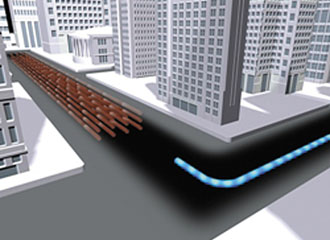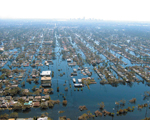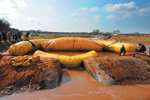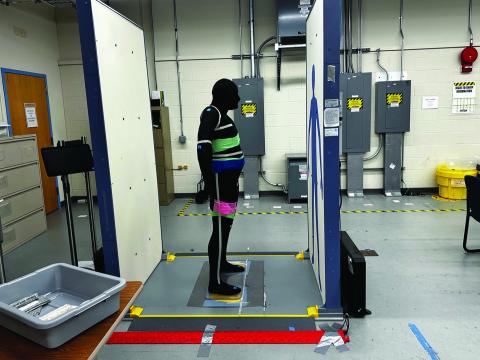Homeland Security Advances Thwart Toxic Gases, Flood Waters, Power Surges
 |
Among the many technologies being developed by the Department of Homeland Security’s Homeland Security Advanced Research Projects Agency (HSARPA) are superconducting electric cables. In addition to being able to carry 10 times the electricity of conventional cables, they also act as their own circuit breakers, cutting off the flow of electricity during potentially destructive power surges caused by weather, accidents or sabotage. |
In the near future, first responders could use cellular telephones to sweep sites for hazardous chemicals and then rapidly seal off mass transit tunnels with inflatable plugs, preventing the spread of toxic gases. These and other technologies are being developed by a
The mission of the Department of Homeland Security’s (DHS’s) Homeland Security Advanced Research Projects Agency (HSARPA) is to study and create new tools and capabilities to aid first responders and to protect the nation’s infrastructure. The agency is working on a variety of capabilities to protect the national electric grid, stop flooding, and detect hazardous chemicals and explosives in airline passengers’ luggage.
One of agency’s research efforts, called Cell All, fits first responders’ cellular telephones and BlackBerrys with small chemical agent detectors. The technology would turn responders’ wireless devices into a warning system, explains HSARPA Director Roger McGinnis. Three firms are involved in developing different technologies. He adds that the detector is not yet small enough to fit inside a cellular telephone, but the program’s goal is to make it fit inside that type of device.
The original idea for the Cell All program was to set up users’ telephones to detect one or two chemicals. But newly developed technologies now enable first responders’ devices to detect thousands of chemicals. Another goal of the program is to make the detectors ubiquitous to help avoid false alarms. For example, if only one cell phone in a team of first responders detects a harmful chemical, it is probably a false alarm. But if a dozen cell phones in the same area register, then it would be a positive reading, McGinnis explains.
HSARPA also has begun testing an inflatable plug designed to seal tunnels in a variety of emergencies. This plug will be used to block smoke and chemical agents and prevent water from flooding a tunnel. A full-scale plug successfully was demonstrated in the
Developing technologies to protect the national infrastructure is another facet of HSARPA’s mission. The agency’s Resilient Electric Grid program is focusing on two technologies. The first is the Stand Alone Fault Current Limiter, a piece of equipment that can prevent faults from cascading through an electric grid. Current fault starts are difficult to stop and can lead to massive multistate blackouts, McGinnis explains.
McGinnis contends that the more important part of the program is the development of a superconducting cable that is inherently fault current limiting. He notes that no electric power cables in use have this capability. When the electric current reaches a certain critical level, such as a power surge, the HSARPA cable changes from superconducting to normal conductivity, which greatly increases the resistance to the electric current flow and stops the current. “The cable acts as its own circuit breaker,” he says.
The superconducting cable is capable of carrying 10 times more power than similarly sized copper wires. The new cable also can adapt automatically to surges and disruptions from lightning strikes, heat waves, accidents or sabotage. HSARPA maintains that a single superconducting cable can replace 12 copper cable bundles, freeing up more underground space for other utilities.
The latest version of the cable was tested in late summer 2009 at the Oak Ridge National Laboratory. The tests, using an 82-foot cable, demonstrated that an electric current can be prevented from cascading and overloading a power grid. The next demonstration is scheduled for this summer to test the stand-alone fault current limiter.
HSARPA is working together with American Superconductor, Consolidated Edison and the Department of Energy (DOE). The experiment will connect two power substations, allowing them to transfer power between each other. McGinnis explains that power substations do not share power with each other because of fault current issues. If one substation is destroyed, a cascade will destroy any other linked substations. The experiment will link two substations to demonstrate the effectiveness of the fault current limiting cable.
If this test is successful, McGinnis predicts the national power grid will change from the current system of substations linking local homes and businesses to something resembling the Internet, where if a substation goes offline, power can be moved from another substation. HSARPA currently is seeking a site to demonstrate a longer cable length. He explains that this longer length is closer to the actual distance required to link substations.
Mitigating flood damage is another area in which researchers are focusing. HSARPA is testing systems to plug breaches in levees. In November 2009, the agency demonstrated two related flood mitigation technologies at tests in
Another system tested at
This summer, the agency will conduct a full-scale demonstration at
The agency also is researching technologies to aid post-incident forensics, such as blast-resistant video devices for use in buses and other types of mass transit. The devices consist of a video camera and a hardened solid-state memory chip. The cameras have a limited amount of memory and function as in an aircraft’s flight data recorder, which rewrites over old data with every new flight. McGinnis explains that the mass transit cameras must survive bomb blasts, fires or accidents with recoverable image data.
In addition to providing forensic data about an incident, if a crime were committed on a bus or rail car, investigators would be able to pull the information to see what happened. “They’ll be able to go in and find that data chip, play back the information and figure out what happened to lead up to the event,” McGinnis says.
 |
 |
HSARPA is developing inflatable plugs that can be used to seal breaches in levees. The devices can be floated into the breach, where water pressure will press them against the opening, cutting off the water flow. |
HSARPA also is examining applications for the camera anywhere that recoverable data can be used to study an accident or other event, including the interior of buildings. However, McGinnis notes that the first priority came from local municipalities who specifically wanted a system to monitor buses and passenger rail cars. McGinnis explains that it is one of HSARPA’s fastest-moving efforts, having been stood up in June 2008 and now moving into a pilot technology demonstration.
Developing new methods to detect biological and chemical agents also is a part of the agency’s research focus. One recently launched effort is a low-cost biological agent detector concept. “We’re looking for an entirely new way to detect a biological agent,” McGinnis says. He notes that existing technologies rely on wet chemistry that requires collecting samples and analyzing them in a laboratory, which can take hours under ideal conditions. The goal is to perform this analysis in a portable, dry environment. The detector could be applied to any system relying on airflow, such as desktop computers, air vents or any device using a fan as a cooling mechanism, because the air current would draw chemicals across the sensor.
Airport security is another research area for the agency. HSARPA is developing a technology called Magnetic Visibility, or MAGVIS, to scan and identify liquids and gels in passenger luggage. McGinnis shares that since the September 11 attacks, travelers have encountered a variety of security restrictions at airports, such as the prohibition against bringing aboard liquid or gel containers larger than two ounces. “To be able to go back to that stage where you just put your suitcase on the belt and run it through the machine and you also get to keep your Starbucks coffee—I would feel extremely pleased if this program is successful. This would have a positive effect every day on almost two million people in this country alone,” he says.
On this project, the agency is working with researchers at the Los Alamos National Laboratory,
This summer, the program will undergo additional tests. The first will be at
WEB RESOURCE




Comments